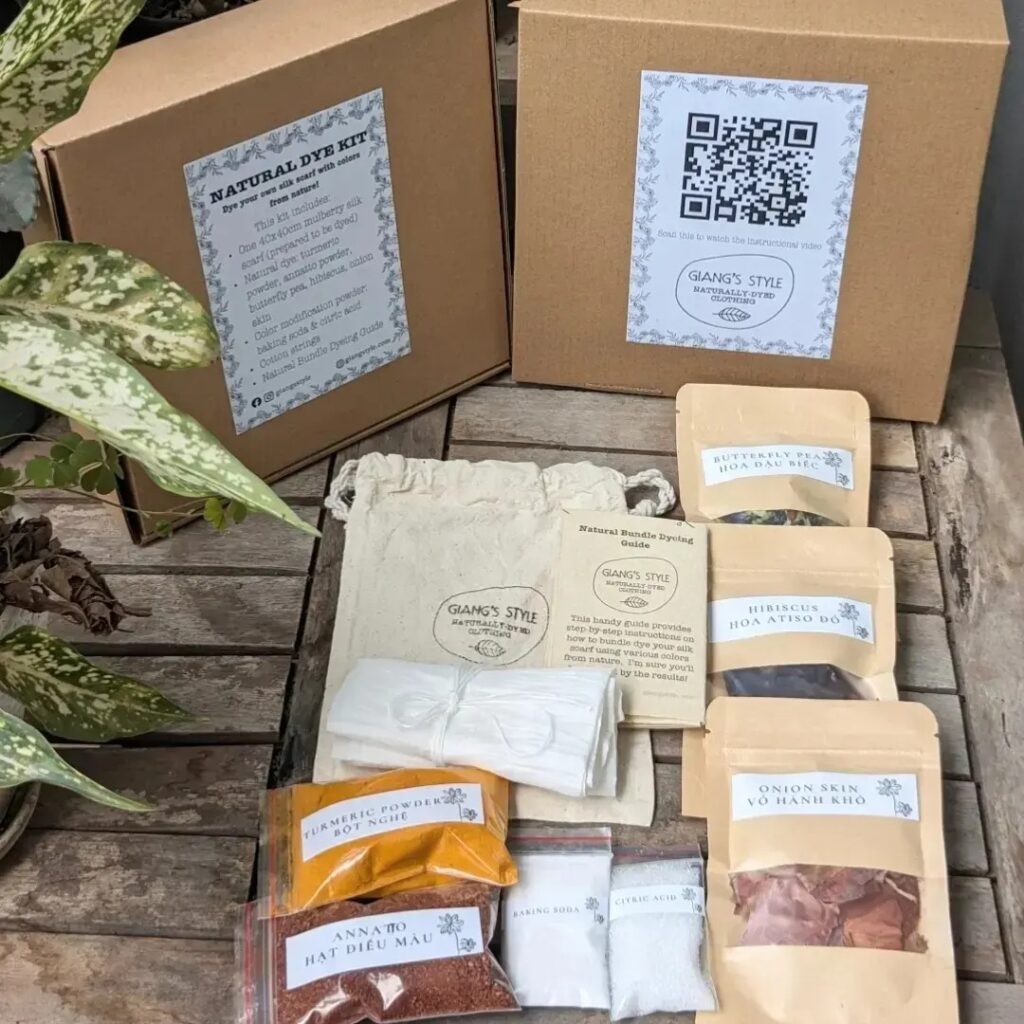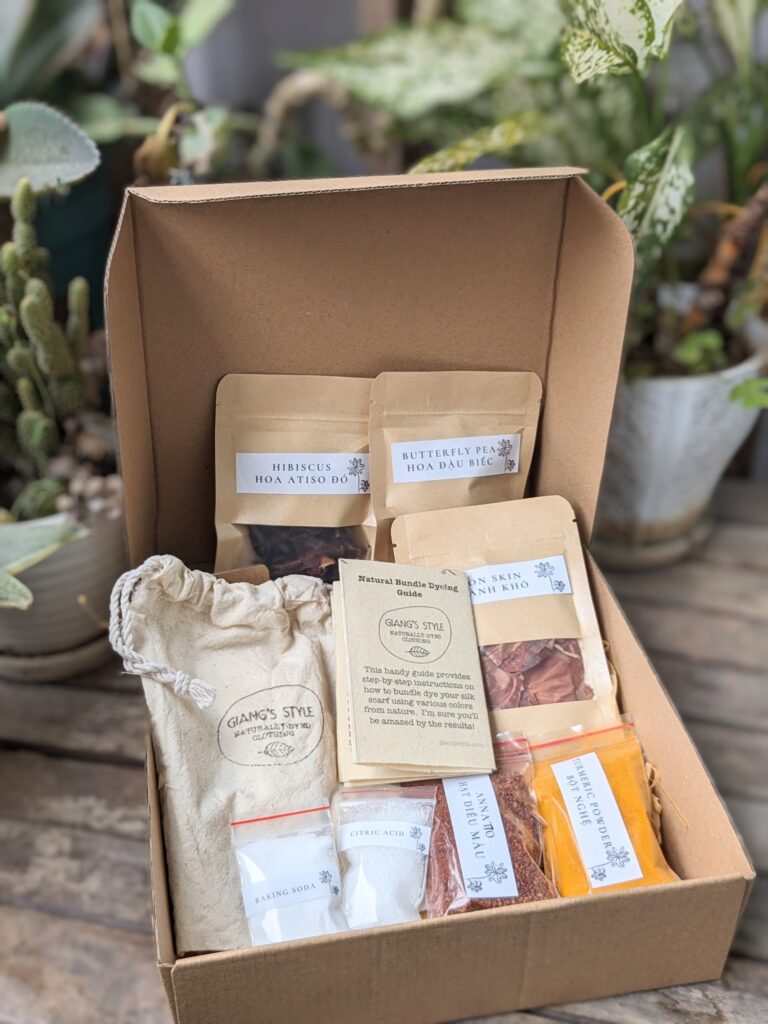What do you need to start with?
-A silk scarf: mulberry silk is good for beginners to start with natural dye
-Natural dyestuff: turmeric and annatto powder, onion skins marigold, rose petals, hibiscus and butterfly pea dried flowers are good material to have great dye results
-A steam pot, or a normal pot with a piece of pure cotton cheesecloth, for steaming
-Strings


Step 1: Scouring
Weigh the fiber dry, then scour. This is essential to remove impurities (oil, wax, other adjectives) from your fiber.
Soak your silk in lukewarm water (30 ºC -40 ºC) in a minimum of 1 hour and rinse thoroughly.
A PH-neutral soap or natural detergent like soapnut enzyme can also be used to scour silk.
This step helps the to even the color application and the natural dye to absorb better into the fiber.
Keep the clean fiber soak in water until you move to the next step.
Step 2: Mordanting
*Measure:
-Alum at 15% WOF (weight of fabric)
-Cream of tartar at 7% WOF
Alum will bond with the fiber and help the color lightfast and washfast.
Cream of tartar is an optional addition to the dyebath to soften fiber, brighten shades, and help the color to pop better.
Dissolve the alum and cream of tartar in hot water in a non-reactive container.
Add the dissolved chemicals to a bucket with warm water at 45ºC. The bucket of water should be enough to cover the fiber when it is added – usually a 30:1 ratio of water to fiber. Stir well.
Keep the silk soak in the mordant bath overnight.
Remove the fiber from the mordant bath. Rinse well in cool water and allow to hang evenly over a non-reactive rod (stainless steel, plastic) until it stops dripping.
If you use my ready-to-dye kit, I have done scouring and mordanting steps.
Step 3: Creating color/pattern
I recommend these combinations to start with:
*2 bags of powder :
-turmeric: create a bright yellow color
-annatto: create a bright orange color
*2 bags of dried flowers:
-butterfly pea: create the blue color
-hibiscus: create pink color
*1 bag of onion skin: create browny-orange color
Arrange the dyestuff
Spread the powder and the flowers on one half of the fabric, or a full piece of fabric, it’s up to you to have a lighter or darker color. Try to cover all the areas, including edges, for the evenest coloring.
You can choose to spread the dyestuff randomly or arrange specific patterns (circles, stripes, etc.)



It’s fun to experiment!
Roll up the scarf tightly, avoiding creases and warp with a string around the bundle. Tie the string tightly so that the dyestuff stays inside the bundle and the colors show up better.


Step 4: Steaming
You can use a steaming pot, or put a piece of cheesecloth over the pot and secure it with rubber bands. This is an easy way to have a steam pot, keep the silk bundle moist and all the dye come out well.
Put the silk bundle on top of the cheesecloth, make sure to keep it wet all the time. Cover the pot with a lid and let steam for at least 30 minutes.
After 15 minutes, rotates the bundle for the even coloring and the best results.



Step 5: Unbundle
Let the bundle cool down, better overnight. The longer you wait, the more time the dye has to get into the fibers.

Step 6: Rinse thoroughly
Remove all the dyestuff (powder/dried flowers) and rinse the scarf thoroughly.
Make sure there is no dyestuff left on the scarf before you proceed to modify it.
Step 7: Modify the color
With this kit, you can make different color scarves. Choose the combination that suits your style:)
The color options are:
-Yellow and/or orange with blue spot: made with turmeric and annatto powder and butterfly pea flowers. Throw in some onion skins if you’d like to have dark/browny orange spots.
-Pink and purple: made with butterfly pea and hibiscus flowers. Throw in some onion skins if you’d like to have dark/browny orange spots.
-You can make it a bit more light purple by soaking it in a pot with citric acid/ vinegar or changing it completely to a blue-green shade by soaking it in a pot with baking soda.
Here’s how to do:
+Fill a small bucket or a pot with warm water. Dissolve citric acid OR baking soda. Soak the scarf in the solution and see the color change in front of your eyes.
+If you would like to have a pink-purple scarf, use citric acid.
+If you would like to dye it blue-green, use baking soda.


Hang air-dry your scarf, let the color set in for a few days before you wash it again to make sure you remove all the leftover dyestuff.
Be gentle with your natural-dyed silk item
-Hand-wash with cold water. If you want to use detergent, use a mild soap/natural detergent like soapnut enzyme.
-Hang dry away from direct sun.
Enjoy your own unique hand-dye scarf for multiple uses: a scarf/hair-tie/turban or accessories to complete your style:)








Natural bundle dye kit includes
-One habotai mulberry silk scarf size 40x40cm inside a cotton bag
(already mordanted and ready to dye)
-Natural dyestuff: turmeric and annatto powder, hibiscus and butterfly pea dried flowers, onion skin
-Cotton strings
-A pocket size instruction with steps by steps to Natural Dye
-Scan QR code to see the instructional video



Choose your color
With this kit, you can create various styles for your hand-dyed scarf:
-Yellow and/or orange with blue spots: turmeric, annatto powder, and butterfly pea flowers. Add onion skins for brownish-orange spots if desired.
-Pink and purple: butterfly peas and hibiscus flowers. Add onion skins for brownish-orange spots if desired.
-Modify the color by dissolving citric acid/vinegar or baking soda in warm water. Soak the scarf to see the color change before your eyes!
-Use citric acid/vinegar for light pink and purple. Add baking soda for a blue-green hue.
-Hang the scarf to air dry, avoiding direct sunlight
Choose the colors that suit your style the best!
Contact us to get a natural bundle dyeing kit now!
